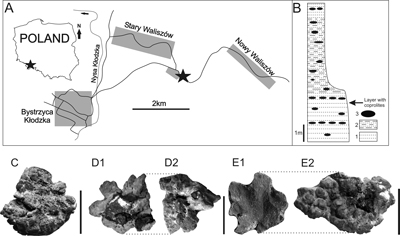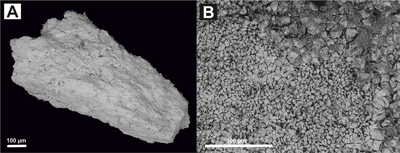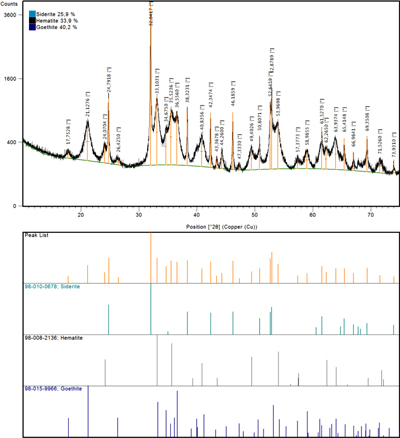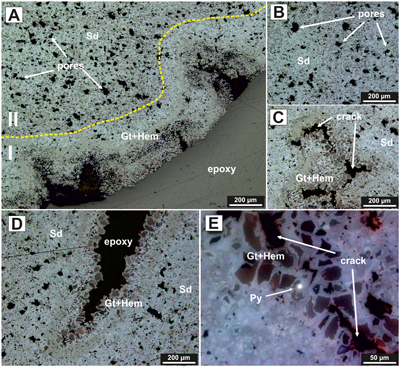◄ Carnets Geol. 16 (13) ►
Contents
[1. Introduction]
[2. Study area]
[3. Materials and methods]
[4. Results] [5. Discussion]
and ... [Bibliographic references]
Department
of Geochemistry, Mineralogy and Petrography, Faculty of Earth
Sciences, University
of Silesia, Będzińska
Str. 60, 41-200 Sosnowiec (Poland)
Department of Geochemistry, Mineralogy and Petrography, Faculty of Earth Sciences, University of Silesia, Będzińska Str. 60, 41-200 Sosnowiec (Poland)
Published online in final form (pdf) on June 23, 2016
[Editor: Bruno Granier; language editor:
Stephen Carey]
Possible coprolites from the Upper Cretaceous (Coniacian) of Waliszów Stary in the Sudetes Mountains (southern Poland) are described for the first time. They are relatively small, irregular in outline, and preserved as goethite, limonite, siderite and hematite. Although it is difficult to identify the producer of these coprolites, they were most probably formed by some fish.
Coprolites; Cretaceous; Coniacian; vertebrates, Poland; Sudetes Mountains.
Brachaniec T. & Wieczorek A. (2016).- Possible vertebrate coprolites from the Upper Cretaceous (Coniacian) of the Sudetes Mountains (southern Poland).- Carnets Geol., Madrid, vol. 16, no. 13, p. 349-354.
Possibles coprolithes de vertébrés provenant du Crétacé supérieur (Coniacien) des Sudètes (Pologne méridionale).- Nous décrivons pour la première fois des coprolithes du Coniacien (Crétacé supérieur) de Waliszów Stary dans les Sudètes (Pologne méridionale). Ils sont relativement petits, de forme irrégulière, et conservés en goethite, limonite, sidérite et/ou en hématite. Bien que le producteur de ces coprolithes soit difficile à identifier clairement, il est très vraisemblable qu'ils furent produits par un poisson.
Coprolithes ; Crétacé supérieur ; Coniacien ; vertébrés ; Pologne ; Sudètes.
Bromalites encompass all fossilized remains of material sourced from the digestive tract of organisms and include coprolites, cololites, gastrolites and enterospires (Hunt, 1992; Brachaniec et al., 2015). Regurgitalites and coprolites are perhaps the most common bromalites (Calvo, 1994; Chin and Gill, 1996; Seilacher et al., 2001; Wings, 2007; Cerda, 2008; Regenmorter et al., 2008; Codorniú et al., 2009; Salamon et al., 2012, 2014; Owocki et al., 2013; Bajdek et al., 2014; Pesquero et al., 2014; Zatoń et al., 2015; Brachaniec et al., 2015). Bromalites constitute an important source of palaeobiological information (Hollocher et al., 2001; Poinar, 2011; Dentzien-Dias et al., 2012; Brachaniec et al., 2015). Bromalites from the Mesozoic strata of Poland have been the subject of rare descriptions (Salamon et al., 2012, 2014; Brachaniec et al., 2015). In this paper we describe coprolites from the Upper Cretaceous (Coniacian) of the Sudetes Mountains (southern Poland).
Field
work was carried out in the Stary Waliszów district in October
2015 (50°18'37.14";
16°42'13.05"; Trzęsiok et al.,
2014) (Fig.
1.A ![]() ). This
area is in the middle of the Sudetic Block, part of the larger Bohemian Massif (Żelaźniewicz
et al., 2011). Upper Cenomanian -
upper Coniacian sedimentary deposits, up to about 1200 m thick, are exposed (Niedźwiedzki
and Salamon, 2005) and consist of siliciclastic and carbonate rocks. Siderite concretions occur in some
sandstone beds.
). This
area is in the middle of the Sudetic Block, part of the larger Bohemian Massif (Żelaźniewicz
et al., 2011). Upper Cenomanian -
upper Coniacian sedimentary deposits, up to about 1200 m thick, are exposed (Niedźwiedzki
and Salamon, 2005) and consist of siliciclastic and carbonate rocks. Siderite concretions occur in some
sandstone beds.
Coprolites
were found in the western part of Stary Waliszów. A section 9 m thick consists
of sandstone with siderite concretions in several beds (basal 3.5 m), overlying
mudstone and muddy sandstone (4.5 m thick), and uppermost sandstone (1 m) with a concretion-bearing layer (details in Trzęsiok et
al., 2014). The coprolites reported
here were found in muddy sandstone at the top of the outcrop (Fig.
1.B ![]() ). The age
of the succession, determined from the presence of inoceramid Volviceramus
involutus (Sowerby), is middle Coniacian (Radwański,
1966).
). The age
of the succession, determined from the presence of inoceramid Volviceramus
involutus (Sowerby), is middle Coniacian (Radwański,
1966).

Click on thumbnail to enlarge the image.
Figure 1: A. Map of Poland and detail of Stary Waliszów district (after Trzęsiok et al., 2014). B. Investigated section. 1 - sandstone, 2- mudstone and muddy sandstone, 3 - siderite concretions (taken from Trzęsiok et al., 2014). C-E. Coprolites from Stary Waliszów, Sudetes Mountains, southern Poland. Scale bar equals 1 cm.
Sixteen specimens were collected and transported to the Faculty of Earth Sciences, University of Silesia, Sosnowiec. Thin sections were prepared for mineralogical/geochemical analysis from samples mounted in epoxy.
BSE and SE imaging was performed with the aid of a Philips XL30 ESEM/TMP scanning electron microscope equipped with an EDS (EDAX type Sapphire) detector at the Faculty of Earth Sciences, University of Silesia. XRD analyses were conducted on light-mineral, powdered samples using a PANalytical X'Pert Pro MPD diffractometer powered by a Philips PW3040/60 X-ray generator and fitted with a 1D silicon strip detector (X'Celerator). The measurements were performed using the Cu Kα-radiation with a wavelength of 0.1542 nm, an acceleration voltage of 45 kV and a current of 30 mA, and with 0.01θ step sizes between the angles of 2.5° and 65° 2θ and a 300 s measurement time per step. The collected data were processed using HighScore+ software and the ICSD database. All XRD analyses were performed at the Faculty of Earth Sciences, University of Silesia.
The microscopic observations were carried out at the Faculty of Earth Sciences, University of Silesia, using an Olympus BX-51 microscope.
The
coprolites examined are relatively small (up to 3 cm longand irregular) (Fig.
1.C-E ![]() ). Delicate ridges, folds and striations on the surface are aligned parallel or
oblique to the long axis. A polygonal pattern of cracks is also present.
). Delicate ridges, folds and striations on the surface are aligned parallel or
oblique to the long axis. A polygonal pattern of cracks is also present.
Thin
sections reveal an internal mineralogical zonation. The outermost part, up to
400 µm thick, is composed of numerous, crystals of Fe-rich hydroxides (goethite
and limonite: Fig. 2.B ![]() ), up to 10-15 µm in size. The internal part is mostly
composed of massive siderite and hematite (Fig. 2.A
), up to 10-15 µm in size. The internal part is mostly
composed of massive siderite and hematite (Fig. 2.A ![]() ). In a few places limonite
forms a "rind" around a siderite and/or hematite core, in particular around
the cracks (Fig. 2.A
). In a few places limonite
forms a "rind" around a siderite and/or hematite core, in particular around
the cracks (Fig. 2.A ![]() ). A few grains up to 2-3 µm of iron sulphide (pyrite) are
present (Fig. 2.B
). A few grains up to 2-3 µm of iron sulphide (pyrite) are
present (Fig. 2.B ![]() ). Micro-XRD analyses showed that the main body is composed of
goethite (40 wt %), siderite (34 wt %) and hematite (26 wt %) (Fig. 3
). Micro-XRD analyses showed that the main body is composed of
goethite (40 wt %), siderite (34 wt %) and hematite (26 wt %) (Fig. 3 ![]() ). Fe-oxyhydroxide phases (goethite and hematite) display
broader peaks than siderite due to weathering. Phosphates (e.g.,
apatite) or silicates including quartz were not found in the coprolite. In some
parts of the coprolite, empty pores and rare fossil inclusions are present (Fig. 4
). Fe-oxyhydroxide phases (goethite and hematite) display
broader peaks than siderite due to weathering. Phosphates (e.g.,
apatite) or silicates including quartz were not found in the coprolite. In some
parts of the coprolite, empty pores and rare fossil inclusions are present (Fig. 4 ![]() ).
).

Click on thumbnail to enlarge the image.
Figure 2: BSE images of the studied coprolites. A. Internal fragment of coprolite composed of siderite. B. Outermost part of coprolite with Fe-rich hydroxide pseudomorphs (goethite and limonite).

Click on thumbnail to enlarge the image.
Figure 3: X-ray diffraction pattern of coprolite from Stary Waliszów, southern Poland.

Click on thumbnail to enlarge the image.
Figure 4: Photomicrographs of textural features of siderite-rich coprolite from Stary Waliszów, Sudetes Mountains, southern Poland. A. Contact between the outermost (I), more oxidised part and the internal (II) zone, composed of siderite. B. Numerous pores in the siderite-bearing part. C-D. Numerous goethite and limonite pseudomorphs after siderite around cracks. E. Rare occurrence of relict primary pyrite. Abbreviations: Gt- goethite, Lm- limonite, Sd- siderite, Py- pyrite.
Coprolites from Stary Waliszów differ from associated concretions in shape, size, internal texture and specific mineralogical composition. According to Trzęsiok et al. (2014) concretions from this locality are relatively large and are commonly spherical or discoidal in outline, and display smooth surfaces. Internally, they reveal a much more complex multilayered texture, and are mostly composed of goethite and siderite with high admixture of kaolinite (12 wt %) and quartz (9 wt %).
Coprolites are usually preserved as phosphates with some admixtures of quartz and/or calcite (e.g., Zatoń et al., 2015, and papers cited therein; Brachaniec et al., 2015). They typically contain remains of fauna and flora, evidence of the producer's diet. In the Stary Waliszów coprolites, phosphates have been replaced by limonite and goethite as a result of oxidation. Rare indeterminate inclusions of skeletal debris were also observed. Similar coprolites of the same mineralogy and morphology were described by Broughton et al. (1978) from the Upper Cretaceous of Canada (op. cit.: Pl. 43, figs. 1, 10, 13-14 & 17-18; Pl. 44, fig. 7). Both Polish and Canadian coprolites display numerous surficial cracks. According to Broughton et al. (1978) and Zangerl and Richardson (1963) such structures might have been associated with faecal degassing in anaerobic conditions. It is difficult to identify the producer of the coprolites. No vertebrates have been documented so far at this locality. However, the coprolites were most probably produced by fish, like a bichir, sturgeon, garpike, bowfin or lungfish that were very common in the Late Cretaceous (e.g., Williams, 1972; Chin, 2002).
Dr. Krzysztof Szopa and Dr. Tomasz Krzykawski (both from University of Silesia, Poland) are thanked for their help during SEM work, some analysis and sample description. Dr. Bruno Ferré (Sotteville-lès-Rouen, France) prepared the French parts of this paper. The authors are greatly indebted to two anonymous reviewers and Bruno Ferré for their constructive comments and helpful suggestions. The project is supported by the Leading National Research Centre (KNOW) of the Centre for Polar Studies for the period 2014-2018.
Bajdek P., Owocki K. & Niedźwiedzki G. (2014).- Putative dicynodont coprolites from the Upper Triassic of Poland.- Palæogeography, Palæoclimatology, Palæoecology, vol. 411, p. 1-17.
Brachaniec T., Niedźwiedzki R., Surmik D., Krzykawski T., Szopa K., Gorzelak P. & Salamon M.A. (2015).- Coprolites of marine vertebrate predators from the Lower Triassic of southern Poland.- Palæogeography, Palæoclimatology, Palæoecology, vol. 435, p. 118-126.
Broughton P.L., Simpson F. & Whitaker S.H. (1978).- Late Cretaceous coprolites from western Canada.- Palaeontology, vol. 21, p. 443-453.
Calvo J.O. (1994).- Gastroliths in sauropod dinosaurs.- Gaia, München. vol. 10, p. 205-208.
Cerda I.A. (2008).- Gastroliths in an ornithopod dinosaur.- Acta Palaeontologica Polonica, Warsaw, vol. 53, no. 2, p. 351-355.
Chin K. & Gill B.D. (1996).- Dinosaurs, dung beetles, and conifers: Participants in a Cretaceous food web.- Palaios, vol. 11, p. 280-285.
Chin K. (2002).- Analyses of coprolites produced by carnivorous vertebrates. In: Kowalewski M. & Kelley P.H. (eds.), Predation on the Fossil Record.- Paleontological Society Special Paper, vol. 8, p. 43-49.
Codorniú L., Chiappe L.M., Arcucci A. & Ortiz-Suarez A. (2009).- First occurrence of gastroliths in Pterosauria (Early Cretaceous, Argentina).- Ameghiniana, Buenos Aires, vol. 46, no. 4, p. 15-16.
Dentzien-Dias P.C., Figueiredo A.E.Q. de, Horn B., Cisneros J.C. & Schultz C.L. (2012).- Paleobiology of a unique vertebrate coprolites concentration from Rio do Rasto Formation (Middle/Upper Permian), Paraná Basin, Brazil.- Journal of South American Earth Sciences, vol. 40, p. 53-62.
Hollocher T.C., Chin K., Hollocher K.T. & Kruge M.A. (2001).- Bacterial residues in coprolite of herbivorous dinosaurs: Role of bacteria in mineralisation of feces.- Palaios, Lawrence, vol. 16, p. 547-565.
Hunt A.P. (1992).- Late Pennsylvanian coprolites from the Kinney Brick Quarry, central New Mexico with notes on the classification and utility of coprolites.- Bulletin of New Mexico Bureau of Mines and Mineral Resources, Albuquerque, vol. 138, p. 221-229.
Niedźwiedzki R. & Salamon M.A. (2005).- Late Cretaceous crinoids from the Sudetes (southern Poland).- Freiberger Forschungshefte Paläontologie, Stratigraphie, Fazies, vol. C507, p. 1-9.
Owocki K., Niedźwiedzki G., Sennikov A.G., Golubev V.K., Janiszewska K. & Sulej T. (2013).- Upper Permian vertebrate coprolites from the Vyazniki and Gorokhovets, Vyatkian regional stage, Russian Platform.- Palaios, Lawrence, vol. 27, p. 867-877.
Pesquero M.D., Souza-Egipsy V., Alcalá L., Ascaso C. & Fernández-Jalvo Y. (2014).- Calcium phosphate preservation of faecal bacterial negative moulds in hyaena coprolites.- Acta Palaeontologica Polonica, Warsaw, vol. 59, p. 997-1005.
Poinar G. (2011).- The evolutionary history of Nematodes: As revealed in stone, amber and mummies.- Brill Academic Pub., Boston, 429 p.
Radwański S. (1966).- Facje osadowe i charakterystyka faunistyczna górnej kredy środkowych Sudetów.- Rocznik Polskiego Towarzystwa Geologicznego, Cracow, vol. 36, no. 2, p. 99-119.
Regenmorter J.V., Videtich P.E. & Neal W.J. (2008).- Coprolites, cololites, and fish fossils in the Mississippian Michigan Formation, Western Michigan.- Michigan Academician, vol. 38, p. 21-35.
Salamon M.A., Niedźwiedzki R., Gorzelak P., Lach R. & Surmik D. (2012).- Bromalites from the Middle Triassic of Poland and the rise of the Mesozoic Marine Revolution.- Palæogeography, Palæoclimatology, Palæoecology, vol. 321-322, p. 142-150.
Salamon M.A., Gorzelak P., Niedźwiedzki R., Trzęsiok D. & Baumiller T.K. (2014).- Trends in shell fragmentation as evidence of mid-Paleozoic changes in marine predation.- Paleobiology, vol. 40, no. 1, p. 14-23.
Seilacher A., Marshall C., Skinner H.C.W. & Tsuihiji T. (2001).- A fresh look at sideritic "coprolites".- Paleobiology, vol. 27, no. 1, p. 7-13.
Trzęsiok D., Krzykawski T., Niedźwiedzki R., Brom K., Gorzelak P. & Salamon M.A. (2014).- Palaeoenvironment of the Upper Cretaceous (Coniacian) concretion-bearing Lagerstätten from Poland.- Palæogeography, Palæoclimatology, Palæoecology, vol. 401, p. 154-165.
Williams M.E. (1972).- The origin of 'spiral coprolites'.- University of Kansas Paleontological Contributions, Lawrence, vol. 59, p. 19.
Wings O. (2007).- A review of gastrolith function with implications for fossil vertebrates and a revised classification.- Acta Palaeontologica Polonica, Warsaw, vol. 52, p. 1-16.
Zangerl R. & Richardson E.S. (1963).- The paleoecological history of two Pennsylvanian black shales.- Fieldiana Geology Memoirs, Chicago, vol. 4, 352 p.
Zatoń M., Niedźwiedzki G., Marynowski L., Benzerara K., Pott C., Cosmidis J., Krzykawski T. & Filipiak P. (2015).- Coprolites of Late Triassic carnivorous vertebrates from Poland: An integrative approach.- Palæogeography, Palæoclimatology, Palæoecology, vol. 430, p. 21-46.
Żelaźniewicz A., Aleksandrowski P., Buła Z., Karnkowski P.H., Konon A., Oszczypko N., Ślączka A., Żaba J. & Żytko K. (2011).- Regionalizacja tektoniczna Polski.- Komitet Nauk Geologicznych PAN, Wrocław, p. 60.